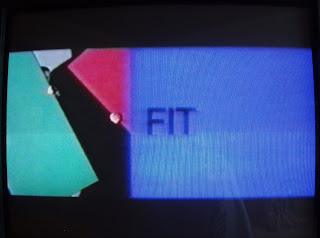Thursday 24 April 2008
The Snowball Effect
Director: Brett Turnball
The music is the driving force behind this peice, the deep bass makes it all so exciting, almost like a chase scene. Its in soft focus, the clours and the light are very important -very soft, yellow, warm colours, the light bleeding into the hall they are in, makes it look very dramatic. theres also a secion in it where its all slow motion with added motion blurrs on the characters, theres also red lighting, all of this completely shifts the mood.
Janneque Draisma
The music and sounds she uses as well go so well with the visuals.
Janneque Draisma is a Dutch choreographer/dancer and director. After an education in classical dance, she studied painting and film in Amsterdam. She then went to Paris where she took lessons in 'corporal mime'! In 1992 she received the prize for 'Best Actress' (Golden Calf) at the Dutch Film festival. Since then Janneque performed in several films, participated in a number of opera productions. At the same time she continued realizing and producing experimental films and theatre performances for which she founded her production company `The Draft Foundation' in 1995. At the moment Janneque is gradually developing three feature film scripts, which she will also direct: a Dutch film, a French musical and an Italian film. She is also a photographer and actress.
This is a picture of her as a sea monster (?)

research
Choreography: Jamie Watton
Director: Charan Goul

The location (the london underground) in this peice is as important as the dance itself, some shots have no dancer oin them at all. Clear narrative, shown by cross cuts.
PULL
Bruce Mclean, David Proud, Ashley Page, Jane Thorburn and Mark Lucas
This discribes itself as a "scultural dance". its about searching for the perfect body. The movements and editing are fosuced around and influenced completely by the props - which make up some of the costumes (huge card hats) and also big boards the dancers transport around like billboards. There are lots of sliding screens and split screens so in the end you dont know whether its the boards moving around or the editing! this is one of the few peices ive seen so far that include text within the dance, almost like headlines. the screen is alos in widescreen format which i think is to remind you of watching films.
MAN IN MOTION
Choreographer: Moniek Merkx
Director: Noud Heerkens
1995
E PUR SI MUOVE
Choreography: Harijono Koeban, Andrea Leine
Director: Peter Delpeut
The entire film is done in one shot, it zooms in and out but stays stationary. Interesting use of blurring - the film starts of completely blurred, you can just see movemet and colour.
CORZAND
Choreogrpher: Clara van Gecol, Angelica Oai
Director:George Bugmans
1993
KADER
madness
Duet
Choreographer: Will Tucket
Director: The Quay Brothers
2000
Tuesday 22 April 2008
Matthew Bourne on dance made for film
Dance and television are natural companions but theatrical dance can often appear constrained by a 2-dimensional TV screen. This series [4 Dance] escapes these confines by making the camera the motivation for the choreography. These pieces couldn’t be performed in the theatre.
Some films tell a clear story and place us in a real world with recognisable characters and situations. Others have a less clear narrative but evoke potent emotions and feelings. And some take pleasure in the movement itself and its relationship with the camera and space. Because dance is not a literal art form, its secrets and meanings are revealed gradually - the interpretation often personal and unique to the viewer. You don’t need to be an expert in contemporary dance to enjoy it – far from it. Each film communicates in its own special way.”
MY breif!
A dance film is one in which dance and film/video are both integral to the work. This simple definition separates dance films from archival records of stage or site specific dance compositions. The placement and movement of the camera, the lighting, the balance of foreground and background, and the composition within the framing of each shot is considered in the overall choreography. A dance film can take many forms: documentary, dance designed for the camera (cine dance or screen dance), a screen adaptation of a stage work, animation, or kinetic abstraction.
“The structure for a dance for the camera, otherwise known as a cine dance or screen dance, may be driven by a kinetic or visual design concept, poetry or narrative, imagery from reality and/or dreams, traditional or idiosyncratic musical forms. The intention may be to produce what cannot be conceived in a live performance or to stretch and condense a multi-media form. The essential difference between an archival record of a stage work and what we are referring to as a dance film, a dance for the camera, is the involvement of the choreographer in a collaboration with a composer, cinematographer, editor, and a director. The choreographer may also assume all those roles him or herself as well. ” – Dance Films Association
"Dance and Screen have been so inextricably linked since the beginnings of cinema that audiences and even many dance makers almost take them for granted. Perhaps this familiarity contributes to why the dance film ‘genre', in relation to other cinematic endeavour, continues to remain under-developed as a singular creative medium. This immaturity has certainly impoverished the growth potential for a nascent critical language or a coherent democratic means to set in place uncontentious qualitative criteria." - Sandy Strallen, Curator of the LIDFF (London International Dance for Film Festival) 2007





